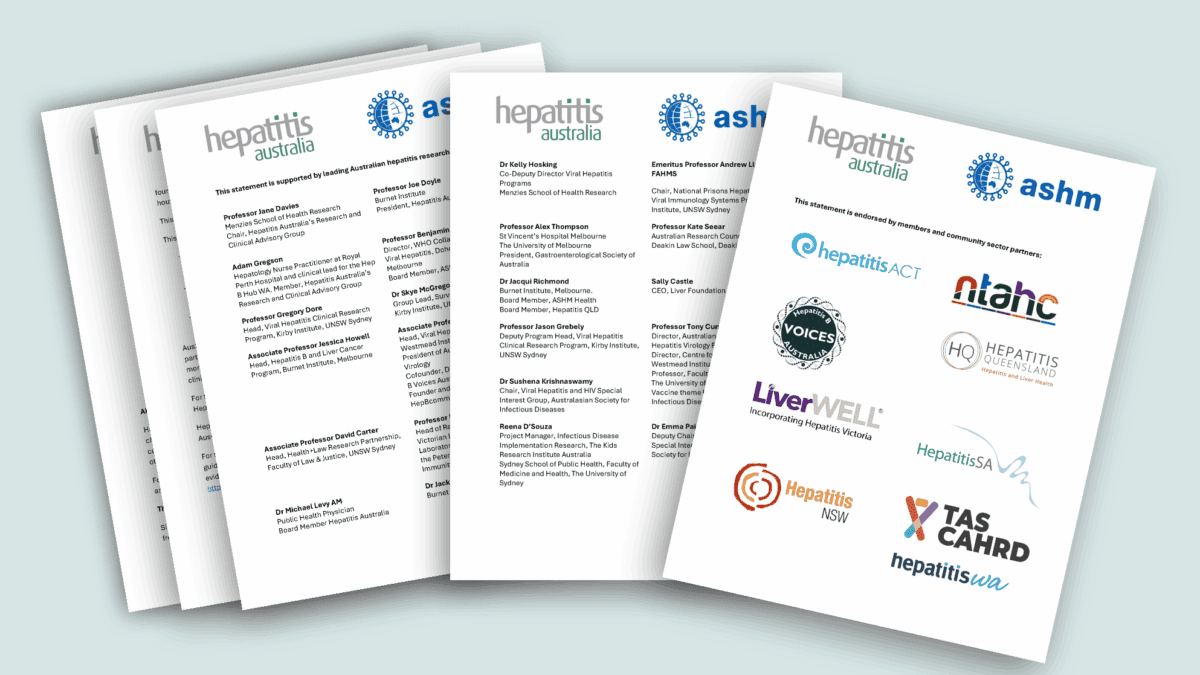Readers of our publications will know hepatitis C well as a blood-borne virus which can lead to cirrhosis, liver failure and other major health problems. Along with hepatitis B, it is the primary cause of liver cancer in Australia—the fastest growing cause of cancer death in the country.
However, since 2016, the entire landscape of hepatitis C has been transformed. That was the year new treatments called direct-acting antivirals, or DAAs, became available. In Australia they were introduced under the Pharmaceutical Benefits Scheme (PBS), at an estimated initial cost to the federal government of $3 billion. DAAs can cure chronic hepatitis C infection in more than 95% of cases. And so, since 2016, over 95,000 people have been treated with them in Australia, and at least 94% of these people were cured. That’s more than half of the estimated number of people in the country with hepatitis C, which is a lot of lives transformed and many potentially saved.
Because of its prevalence among people who have injected illicit drugs, chronic hepatitis C is a heavily stigmatised condition. This is certainly the case in Australia, where this group are the key population affected by the virus, and where illicit drug injecting is criminalised in most jurisdictions. People who contract the virus often go on to experience discrimination and stigma, often in extreme and damaging forms.

Such stigma and discrimination can happen at work, and in intimate and family relationships, but has been most documented in healthcare settings, where it can disturb or even block access to some of the most basic and vital forms of care. This means that stigma can injure or kill. Stigma and discrimination is also a legal issue, and can rear its head in contexts where people apply for insurance, citizenship, and more. Among some people with, or treated for, hepatitis C, it has been such a common experience in their life with the disease that it starts to seem ordinary.
So what about the DAA treatments for hepatitis C, far simpler and more effective to administer than previous treatments, and been hailed as ‘ground-breaking’ and ‘game-changing’ for hepatitis C and people affected by the virus. What changes have these revolutionary curative treatments brought to the stigma and discrimination associated with hepatitis C? Does their advent herald a transition to a truly ‘post-cure world’? What does life look like for people after treatment, and does the stigma and discrimination that often accompanies it go away when they clear the virus? Or do people with a history of hepatitis C still experience stigma and discrimination? If so, where does it occur and in what ways?
Does their advent herald a transition to a truly ‘post-cure world’?
Also, given there are forms of structural discrimination, inequity and stigma baked into laws, policies, and service practices, are there systems and mechanisms from before the advent of DAAs that need updating? Which laws, policies and practices are in need of reform so that people with or treated for hepatitis C can live better, less burdensome lives?
Researchers at the Gender, Law and Drugs (GLaD) program at La Trobe University, Melbourne, wanted to know the answers to these questions, and for three years have been running the Post-Cure Lives Project. This Australian Research Council-funded project, led by Associate Professor Kate Seear, with a team of five chief and associate investigators, and three project staff, has been investigating these questions through a number of different methods of data collection and analysis.
This included interviews with people who have experienced these treatments across three states in Australia, and interviews with people who work with affected communities across law, policy and service provision, including in drug user organisations, legal services, and government departments developing and implementing new policy on hepatitis C.

For the first time ever, the project mapped the laws and legal statutes, and the state and Commonwealth policies relevant to the virus to then analyse how they shape hepatitis C-related stigma—either in ways that reduce or amplify it—and whether they are in need to reform.
All of the work has been focused on the goals of better understanding the experience of hepatitis C in the era of cure, in what ways hepatitis C-related stigma and discrimination persists, and how to tackle it. Although the focus has been on the unique context of Australia, the project’s findings will have worldwide application and ramifications, particularly as other countries follow Australia’s lead in working to scale up the provision of DAA treatment and pursuing the World Health Organization’s global goal to eliminate hepatitis C.
In August 2023, the GLaD team released their summary report from the project. It includes an overview of findings, as well as a list of recommendations for reforms to law, policy and practice in Australia. These recommendations all aim to reduce the stigma and discrimination related to the virus, to make life better for people with (a history of) hepatitis C in various ways, and to support viral elimination.
The report was launched at an event that included reflections on life after treatment, highlights from the project, with a robust discussion of its recommendations, and how they might be implemented among a range of stakeholders in the sector. The final report (which can be read here) contains a lot of detail, so here we’ll look at some of the key findings and recommendations.
Findings
The findings, collected from service providers and the affected community, were wide-ranging:
- Stakeholders who work with hepatitis C-affected communities consider the advent of direct-acting antivirals (DAAs) to have been ‘game-changing’ for affected people and remain optimistic about new treatments and the impact of efforts to eliminate hepatitis C in Australia. Some suggest that new treatments have the potential to reduce stigma and discrimination by changing the idea of hepatitis C from being a ‘chronic’ disease to a curable one, reducing the sense of punishment associated with treatment, and enabling people to feel a sense of pride in the completion of treatment that alleviates feelings of shame they previously may have had.
…people with a history of hepatitis C may continue to experience stigma and discrimination in legal contexts after curative treatment.
- People who have undergone treatment with DAAs reported largely positive experiences of treatment. Some said treatment had positive social effects, including reducing feelings of being an ‘infectious person’, reducing fears of infecting other people, and strengthening intimate relationships (e.g., with family, partners and friends). However, many continued to experience hepatitis C-related stigma and discrimination after treatment, especially in healthcare settings, and did not feel that treatment had changed that.
- The national and state strategies have begun to address post-cure concerns; however, these remain largely focused on medical surveillance, and the prevention of re-infection.
- Hepatitis C can linger in people’s lives after being cured, including via administrative systems, legal mechanisms and medical records. Certain legal processes have the potential to ‘remake’ hepatitis C after cure, meaning individuals may be medically cured and yet legally marked as perpetually ‘having’ hepatitis C. This means people with a history of hepatitis C may continue to experience stigma and discrimination in legal contexts after curative treatment. Concerns about this arose in both stakeholder and lived experience interviews, including via reports that hepatitis C antibodies are often misinterpreted for and treated as the virus itself, including in healthcare settings.
- In criminal case law, the distinction between hepatitis C infection and disease is consistently blurred. The criminal law continues to regard hepatitis C as serious and disabling, despite the advent of cure. This has implications for criminal law sentencing, in which hepatitis C can operate as a mitigating factor leading to reduced sentences for offenders affected by the virus. However, it may also be an aggravating factor in sentencing, particularly where victims are infected or at risk of infection by the virus. Understandings of the virus also have implications for criminal compensation cases, as awards can be increased when victims are either put at risk of contracting the virus or where the virus is transmitted through the offender’s act of violence.

- In some legal contexts where cases were heard and decided since the advent of DAAs, people with hepatitis C were no longer conceptualised as ‘impaired’ or ‘disabled’. These shifts in rhetoric and judgment have seen hepatitis C reconstituted as something that can be cleared, via cure, enabling the individual to become ‘able-bodied’ for legal purposes, and creating the expectation that, once cured, the virus will no longer affect them. These transformed legal understandings of the virus affect rights and entitlements, including access to residency, social security and other social benefits.
- Insurers may be relying on outdated actuarial data regarding hepatitis C, with reports that chronic hepatitis is still being considered a risk among insurance providers, even after treatment. This means that people with a history of the virus may not be granted insurance coverage or may be charged higher premiums. In some instances, this may amount to unlawful discrimination.
- Individual experiences of treatment are extremely diverse. Treatment can be experienced as transformative, life-changing or lifesaving; as a huge relief, or as deeply disappointing and not living up to hopes and expectations. Discussions of the cost of new treatments to taxpayers and the government have shaped some people’s treatment experiences, which some of our participants described as a form of luck, good fortune, or a gift contingent on the beneficence of the state. This suggests that among people treated for hepatitis C, not all feel entitled to health care. These dynamics could inadvertently discourage some people with hepatitis C from accessing treatment, either initially or again in the case of re-infection.
…cure is not always conceived of as an end to hepatitis C. The virus may have social and symbolic ‘afterlives’…
- Stakeholders suggested that the ‘democratisation’ of access to treatment and other changes to healthcare, including the normalisation of hepatitis C (broadly defined as its expansion into primary health care), had the potential to reduce stigma by ‘normalising’ the virus.
- However, stakeholders and people who have undergone treatment for hepatitis C remain concerned about ongoing forms of hepatitis C-related stigma and discrimination affecting people after treatment, including the stigma associated with injecting illicit drugs. Cure is not always conceived of as an end to hepatitis C. The virus may have social and symbolic ‘afterlives’. Both groups shared concerns about several other issues, including aspects of hepatitis C epidemic surveillance (e.g., named notifications and the digitisation of health records), and how these may continue to affect people with a history of the virus, including their ability to access healthcare, their right to privacy and their ability to control the disclosure of their history of hepatitis C.
- Novel approaches in hepatitis C policy and health care related to finding and treating people who are undiagnosed or ‘lost to follow up’ may present risks to people with a history of hepatitis C by compromising processes of informed consent to testing.

- In the personal meanings and narratives that people ascribe to treatment, cure is not always conceived of as an end to hepatitis C. The virus may have social and symbolic ‘afterlives’, including in ongoing experiences of stigma and discrimination. People who have undergone treatment for hepatitis C said they felt that the record of the virus on their medical records led to stigmatising and discriminatory treatment in health care. Additionally, not everyone feels the desire to completely leave hepatitis C behind them after treatment, as some find value in their personal experience of living with the virus.
- Current approaches to hepatitis C care, including the cascade of care, do not sufficiently address the needs of people after treatment, and a range of health-related and other needs remain unmet among this cohort.
- For people who have experienced hepatitis C-related stigma and discrimination, mechanisms for feedback or complaint are flawed. Existing mechanisms pose a significant burden on potential complainants, many of whom do not believe that their experiences are ‘worthy’ of complaint in the first place. Together, these forces discourage feedback and complaint, and need to be addressed.
Key recommendations
The following recommendations seek to reduce experiences of hepatitis C-related stigma and discrimination, including among those who have been treated for the virus. To that end, they propose the development of new policies, legal mechanisms and systems, alongside reforms to or improvements of existing ones. While each of these recommendations are targeted to a specific government or non-government organisation or to a specific sector, other relevant organisations or stakeholders may be engaged in these actions. All these recommendations are prefaced by the guiding principles that:
- Their development and implementation involve meaningful partnership with peer and peak organisations and the communities of consumers they represent, with due resourcing of their time and expertise.
- Any new policies, laws and initiatives, and any changes to existing mechanisms must recognise and draw on the individual and collective expertise of people with (a history of) hepatitis C and communities affected by the virus.
- Where relevant, consideration to the specific experiences and needs of priority groups affected by hepatitis C should be given. In the development and implementation of any of these recommendations, we recommend that responsible bodies consult the priorities outlined in the Harm Reduction International 2023 Australian Conference Declaration.
Policy recommendations
The long list of recommendations call for action from both state and federal governments.
- Responsible departments at federal, state and territory levels should work together with relevant consumer and advocacy groups to develop a health data justice framework that balances the benefits of pathways into hepatitis C health care with the risks associated with the use, re-use, and re-purposing of medical and health data to access such care.
- The Department of Health and Aged Care and its state and territory equivalents should develop stigma-sensitive workforce training and education programs designed for and made available to all people who work with hepatitis C-affected communities.
- Federal, state and territory hepatitis C strategies and action plans should contain an explicit focus on post-cure life, to ensure they address both the medical and other needs of people cured of hepatitis C. This should include explicit goals to reduce the stigma and discrimination that endures for many people after treatment.
- The Communicable Disease Network and/or other responsible bodies should review existing national, state- and territory-based systems of hepatitis C notifications, with consideration given to removing name requirements and other personal/identifiable information for new notifications or to introducing opt-in mechanisms for named notifications.
…scrutinise new testing and treatment models (including strategies to ‘find’ undiagnosed or untreated people) for potential breaches of privacy or consent, or other unintended consequences…
- The Department of Health and Aged Care should ensure that the National Hepatitis C Testing Policy includes robust, opt-in, informed consent processes on all occasions of hepatitis C testing.
- Hospitals, health services and research ethics departments should scrutinise new testing and treatment models (including strategies to ‘find’ undiagnosed or untreated people) for potential breaches of privacy or consent, or other unintended consequences for the health and human rights of people with (a history of) hepatitis C.
- The Department of Health and Aged Care should ensure that, if human rights are to be acknowledged in the Sixth National Hepatitis C Strategy, any reference to human rights should not be limited to specific rights and should incorporate strategies and methods for ensuring that rights are not unjustifiably or unreasonably restricted.
Legal Recommendations
Among other recommendations, the report called for the legalisation of personal use/possession of drugs, establishment of a charter of healthcare rights for people with hepatitis C, and accessible information to support individuals in understanding their legal rights.
- All jurisdictions in Australia should legalise the personal use/possession of drugs and decriminalise the use/possession of injecting equipment.
- Federal, state and territory governments should work together through the National Cabinet to ensure that Australia is meeting its human rights obligations to prisoners, including the obligation to provide equality of health care and harm reduction through the establishment of needle and syringe programs in Australian prisons.
- The Attorney-General’s Department and its state and territory equivalents should consider legislative reform to protect privacy rights over health information, including hepatitis C.
- The Australian Commission on Safety and Quality in Healthcare or another responsible authority should establish a charter of healthcare rights for people with (a history of) hepatitis C, including provisions for the privacy of health records, the use of hepatitis C notifications data, and the legal requirement to provide informed consent for testing.
- The Australian Human Rights Commission and its state and territory equivalents should develop guidelines and fact sheets that support individuals to understand their legal rights and support duty holders to understand their legal obligations to prevent and respond to hepatitis C-related discrimination in workplaces and other settings.
…explore the viability of law reform to enable people cured of hepatitis C to remove their history of hepatitis C infection and/or treatment from their medical records or restrict access to that information.
- The Office of the Australian Information Commissioner and its state and territory equivalents should develop guidance on privacy rights and dealing with unwanted disclosure of hepatitis C.
- Federal, state and territory governments should undertake comprehensive law reform in recognition of the advent of curative hepatitis C treatments, with particular attention to discrimination law, migration law, insurance law and criminal law.
- State and territory law reform commissions and/or parliamentary committees should explore the viability of law reform to enable people cured of hepatitis C to remove their history of hepatitis C infection and/or treatment from their medical records or restrict access to that information.
Practice recommendations
The report also made recommendations for training:
- Federal, state and territory governments should fund relevant organisations to develop and deliver privacy, healthcare rights, stigma-sensitive practice, and anti-discrimination training for people working with hepatitis C-affected communities in healthcare, legal and other settings.
- The Australian Health Practitioner Regulation Agency and its state and territory equivalents should introduce or review mechanisms for consumer feedback and complaint in healthcare settings attended by people with (a history of) hepatitis C. These mechanisms should be robust, transparent, accessible and support the provision of quality stigma-free healthcare.
Other recommendations
Other recommendations address access to insurance, disability support pension and immigration policies.
- The Financial Services Council should develop a new guidance note on insurance underwriting for hepatitis C that reflects developments in treatment and with a view to addressing unfair exclusions, increased premiums and policy voiding based on (a history of) hepatitis C as well as stigma-sensitive questioning in insurers’ questionnaires.
- The Department of Social Services and/or other funding bodies should provide support for further research into how the advent of curative treatment has affected people with hepatitis C who were or are on the Disability Support Pension.
- The Departments of Foreign Affairs and Trade and of Home Affairs should improve migration decision-making processes in relation to refugees and migrants with hepatitis C by supporting further research on access to hepatitis C treatments in different countries to be included in country information reports.
The project’s work dovetailed with several relevant national and state inquiries, legislative debates, law reforms and community consultations, including the development of the Sixth National Hepatitis C Strategy 2023-2030. The Draft Strategy took up recommendations from the project, including recommendations to establish baseline measures for legal and human rights issues and a strengthened emphasis on addressing post-cure life.
The research team also contributed to the development of the inaugural National Stigma and Discrimination Reduction Strategy through its public consultation process; and gave written and oral evidence to the Inquiry into the New South Wales Mandatory Testing Bill 2020, expressing opposition to the Bill on the grounds that it undermined efforts to reduce the stigma and discrimination associated with blood-borne viruses and was in tension with public health and disease prevention efforts.
Last updated 10 April 2025
More from:
Enjoyed this article? Subscribe to be notified whenever we publish new stories.
Subscribe for Updates









